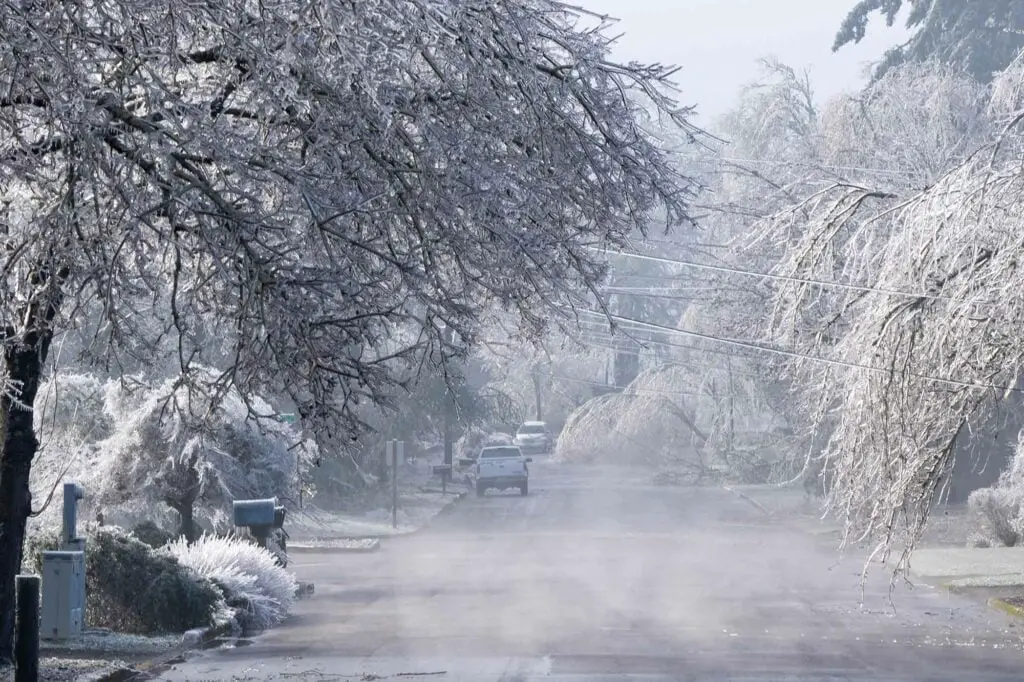We’ve all been through it if you live in an area that falls below freezing in winter. It’s freezing out yet raining. Within minutes, everything becomes an ice rink. Drivers lose control of their cars, everything grinds to a halt. It’s not fun.
Then there are the power outages from the weight of the ice on the trees, making things even more inconvenient. So what causes freezing rain, one of the most hazardous winter weather types? Keep reading.
What is Freezing Rain?
Freezing rain develops when a layer of warmer air is found between a precipitating cloud and colder ground. While the precipitation starts as snow after falling through the cloud where cold air is still present, it passes through the pocket of warmer air and melts.
Closer to the ground, temperatures are at or slightly below freezing. Since this thin layer of colder air is shallow, the raindrop doesn’t have a chance to refreeze. Surfaces, such as tree limbs, power lines, cars, and roads, however, are below the freezing point, allowing the supercooled droplets to freeze on contact with the cold surface.
Another place that freezes over quickly is elevated roadways. Since there is no warm ground beneath it, freezing rain accumulates much more rapidly. It’s not unusual for a road to be mostly clear of ice, and bridges and overpasses nearly impassable.
The accumulation of ice on surfaces adds additional weight, which is why tree limbs and power lines fail during severe ice storms.
What’s the difference between sleet and freezing rain? Find out here.
Where Freezing Rain Occurs
Freezing rain occurs in areas typically east of the Rocky Mountains, including Canada and the northern United States. However, it can happen anywhere where ground temperatures are below freezing at the surface, and there is a large enough layer of warm air to melt snow entirely before it reaches the ground.
If the shallow layer of air is larger — at least several thousand feet — sleet occurs instead. It is not unusual for a period of snow or sleet to occur at the beginning of an ice storm while the layer of below-freezing air is large enough. In many cases, the warm layer eventually wins out, and precipitation falls as plain rain.
If this process takes a long time to occur, then the risk for significant ice accumulations increases dramatically.
Types of Weather Warnings for Freezing Rain
When conditions are favorable for freezing rain, the National Weather Service will handle it using one of three types of weather alerts: a Winter Weather Advisory, a Winter Storm Warning, or an Ice Storm Warning.
Winter weather advisories are issued when only minor accumulations of ice are expected. A Winter Storm Warning for ice accumulation is issued if more substantial ice accumulations are expected to hamper travel significantly. The worst ice storms, where there is a high likelihood of significant ice accumulations, typically warrant an Ice Storm Warning.
Like other winter alerts, the ice accumulation necessary for each alert varies from region to region.

Notable Ice Storms
Ice storms can vary in severity and duration. Some of the most infamous ice storms include:
The Ice Storm of 1994
One of the worst ice storms to hit North America affected portions of eastern Ontario and southern Quebec, including Montreal. More than one million people lost power during the height of the storm on January 14-15th.
The Great Ice Storm of 1998
Similar to the 1994 storm, widespread freezing rain caused havoc across parts of Atlantic Canada. Power companies reported more than 300 000 power outages in New Brunswick and Nova Scotia on January 14-15th alone.
The Southeast Snowstorm of 2000
This was a very unusual ice event for North Carolina, where ice accumulations of up to one foot were recorded in some areas. This storm was responsible for over 100 traffic accidents and thousands of power outages, including the loss of power at Walt Disney World.

What You Can Do During an Ice Storm or Freezing Rain Event
Being prepared is critical when you are under winter weather advisories. Just because the sun may be shining where you are doesn’t mean the storm is over.
Keep your gas tank at least half full in case icy roads restrict access to local service stations and have a supply of non-perishable food that won’t spoil if there’s no power. It would help if you also kept flashlights or battery-powered lanterns on hand, as well as extra blankets.
It’s also important to stay safe during the winter weather event, so keep your distance from power lines and avoid driving through standing water if possible. If you must drive, be sure to use caution when on elevated surfaces like bridges or overpasses since they may freeze more quickly than other areas of the roadways.
While it’s impossible to predict precisely where severe ice accumulations will occur, the best way to stay prepared for an ice event is by staying informed. The National Weather Service issues winter weather advisories and warnings well in advance of storms so that you can be sure to take all necessary precautions before they strike.
These alerts are often broadcast on NOAA Weather Radio, so we recommend picking up one if you haven’t already. Ice storms can be very dangerous, and even deadly if you’re caught in one, especially in a car.
Wrapping Up

In conclusion, we hope we’ve been able to answer some questions you may have had about freezing rain and what it entails. We also want to stress that the best way to stay prepared for an ice or winter weather event is by staying informed and taking action as much in advance of a storm as possible. If you know where severe accumulations are likely to occur, you can prepare your home and family accordingly.
We hope this blog post has been helpful for you! We would appreciate any feedback or additional questions on the subject of freezing rain in the comments section below.


